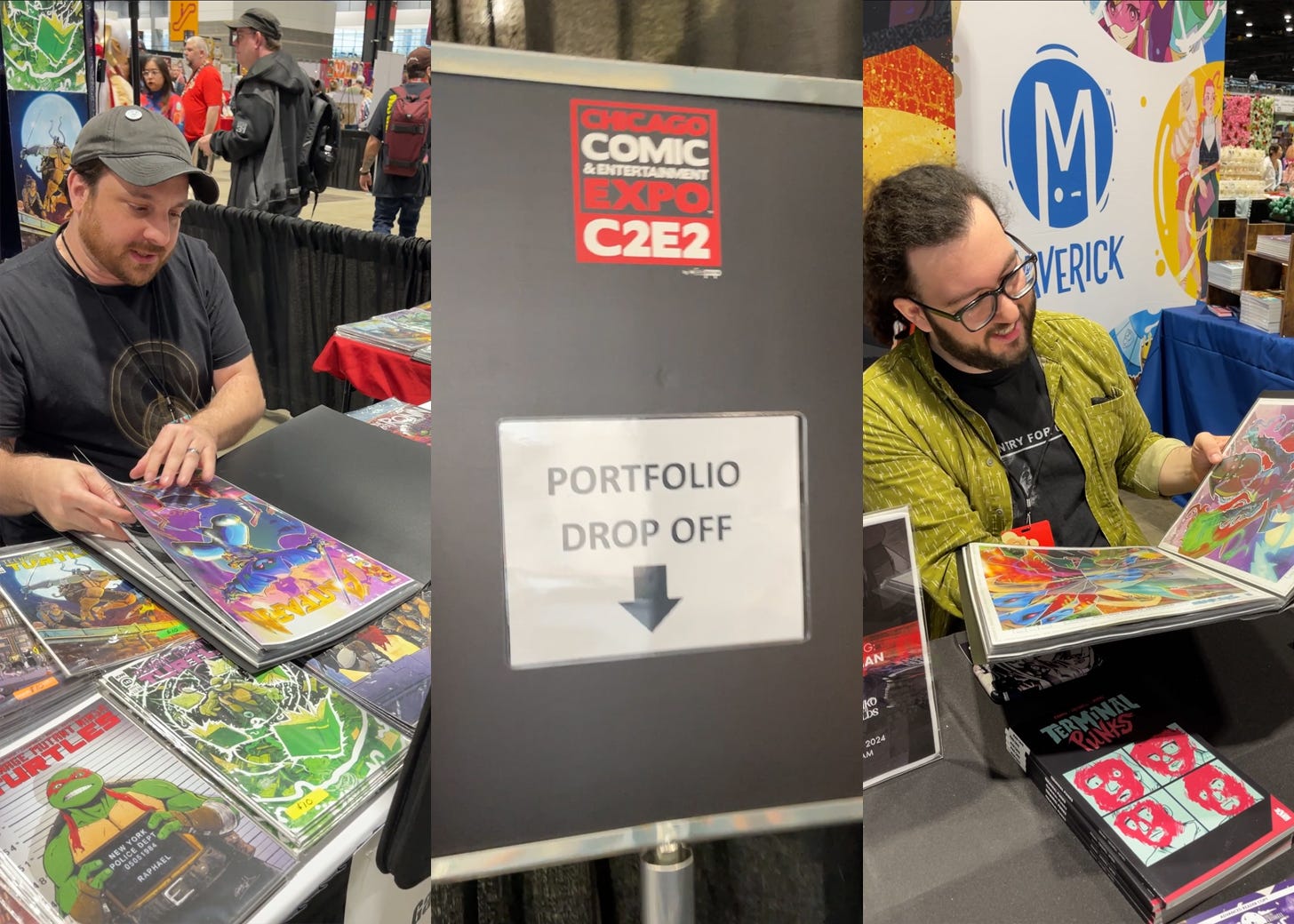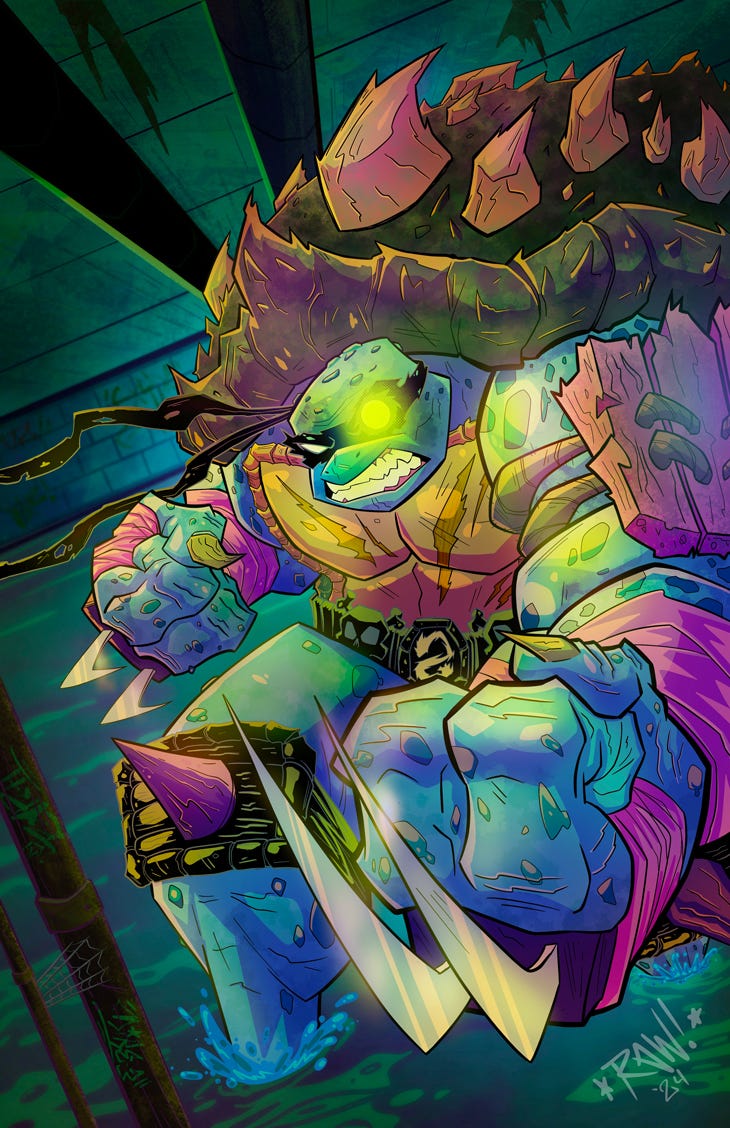I Took My Comic Portfolio to C2E2—Here’s What I Learned
This post is a long time coming. I’ve had this drafted up for like a year and was considering making it a YouTube video or TikTok/IG Reel, but ultimately I’m just lazy these days even though I used to be a social media marketer and video editor for most of my life, so this meager Substack post will have to do. Let’s get into it.

Back in April of 2024, I took my portfolio to C2E2 (Chicago Comic & Entertainment Expo), had it reviewed by a bunch of artists in Artist Alley, and even got picked for a DC Comics portfolio review. Wild, right? I went in thinking, “Okay, this is either gonna be super validating or a massive reality check.” Spoiler: It was kinda both.
I learned a ton, had my brain scrambled by wildly conflicting feedback, got a kaiju-sized confidence boost, and even had an artist I admire recognize my work before I could say anything. So, if you’ve ever thought about getting your art reviewed at a con, let me be your cautionary tale/encouraging success story.
Here’s the breakdown.
Lesson 1: I’m Actually on Track?!?
Mannn, lemme tell you. I thought I’d roll up, get roasted, and leave with a to-do list of skills to brush up on. Instead, almost every artist who looked at my work said I should already be making comics professionally. (brb while I go lie down and process that for 7-9 business days.)
I’m telling you this not to flex (okay, maybe just a lil’ 💪🏽) but because I genuinely didn’t believe I was at that level yet. It turns out, your own self-doubt is often way louder than reality. So if you’ve ever felt like you’re not “good enough” yet, you might actually be a lot closer than you think.
Lesson 2: Fundamentals Will Betray You When You Least Expect It
Look, when you’re deep in the trenches of drawing a comic, it’s easy to forget basic art things you 100% know.
Style vs. Structure Smackdown: One artist hit me with a brain-melter: my cartoony style is solid, but they could tell I was leaning on intuition instead of a firm grasp of anatomy. OOF. That stuck with me. Babs Tarr also dropped some wisdom, telling me to push my poses and expressions more to amp up the mood in my pinups. Which—yeah! That was the missing puzzle piece I couldn’t quite put my finger on. Turns out, even the fun, exaggerated stuff still needs a strong foundation. Who knew?? (Answer: everyone. Everyone knew.)
You should be able to tell what’s happening on the page even without word balloons. I’ve read every major book on drawing comics, so I’m sure that tidbit was in the back of my brain somewhere, but my DC portfolio review brought it to the forefront and turned it into a shining beacon to strive toward with my work.
Foreground characters should be a different color temperature than the background so they pop. (Duh, but also—how did I forget this?)
Establish your spatial positioning clearly so readers aren’t lost. (Double duh, but okay, fair point.)
If you’re drawing a tropical swamp, make sure the plants you draw actually belong in a tropical swamp. (Not me out here designing an ecosystem that makes zero sense…)
It’s the little things that separate “good” from “pro-level polished.”

Lesson 3: Art is Subjective, and It Will Hurt Your Brain
Here’s where things got weird. Just about every artist complimented my panel layouts and storytelling—except for one (who I admire greatly) who said my page layouts needed work. Another challenged me to focus more on simple rectangular grid layouts for my next comic rather than the splashy anime-style layouts I had in my portfolio, and that’s exactly what I did with my short comic “C is for Cursed” which was part of the Columbus Cartoon Coalition 2024 Anthology as well as two other short comics I did for various anthologies earlier this year.
One artist said I put too much detail in backgrounds (waste of time!), while another said I didn’t have enough detail in backgrounds (make it feel like I’m there!).
One told me my work looked too clean (go grittier!), while another said they loved how crisp my linework was (reminds them of animation cels!).
At first, I was like, what am I supposed to do with this?? But then I realized: this is just the nature of art. No two pros are gonna agree on everything. The takeaway? Take the feedback that resonates with you and aligns with your artistic goals—leave the rest.
The DC Comics Review: Big Moment Energy
Okay, now for the wildest part. After dropping my portfolio off in a bin and crossing my fingers, I somehow got selected for a DC Comics portfolio review, which I assumed meant imminent destruction. Instead? The editor LOVED my work. Oh, and the editor was the one and only Katie Kubert… comic book royalty!
Her exact words when sitting down before opening my portfolio were “Okay, this one was REALLY fun!”(!!!). After going page by page and telling me what she loved about each piece (“This character design is so good!” “I LOVE this expression!” “This pose is so dynamic!”), she went back to the first page and actually had to slow down and look harder to find things to critique. When she did, her notes were small but impactful (see LESSON 2). I even went back and redid some pages based on her feedback, and they turned out way better.


Before our time was up, I asked her what I should do next if I want to break into comics and she just replied, “You’re already doing it! Keep making comics!”
And that’s what I spent the reset of 2024 doing!
This experience taught me two things:
Editors see things differently than artists. They’re not just looking at skill; they’re looking at how you think as a visual storyteller.
I might actually be ready for this. (Again, processing...)
Unexpected Perks: “Wait, I Know This Art!”
One of the coolest moments? Michael Dialynas (The Woods, TMNT, Wynd) was flipping through my portfolio and went, “Wait!! I know this stuff! You did that sick Slash piece, right?”
Sure enough, the very Slash piece he was thinking of was a few pages later in my portfolio. My brain short-circuited. Someone I admire already knew my work!
That moment alone made the whole thing worth it.
If I Could Do It Again (And I Will), Here’s What I’d Do Differently
Get more reviews. I was nervous of bothering people at their booths at first, so I missed out on some feedback opportunities. Next time, I’m hitting up everyone.
Bring a smaller portfolio. This nugget of wisdom comes from Michael Dialynas. Since my work is digital, a big 11x17 portfolio wasn’t necessary—an 8.5x11” binder would’ve been just as effective. Ultimately, it’s up to you.
Be mindful at Artist Alley. If someone reviews your work, buy something from their table—it’s just good manners. Granted, cons are expensive, so do what you can. Also, don’t clog up their table for too long and block sales.
Final Thoughts: Should You Get Your Portfolio Reviewed?
YES. 100%. If you’re an artist wanting to break into comics, getting pro feedback is one of the best things you can do.
You’ll get brutally honest critiques that will level you up.
You’ll learn what you’re doing well (which, trust me, is just as important as what needs work).
You might even get a huge confidence boost you didn’t know you needed.
I left C2E2 feeling more fired up than ever to keep making comics. If you ever get the chance to do portfolio reviews at a con, DO IT. Even if you’re nervous. Especially if you’re nervous.
Now, back to drawing. The next portfolio review ain’t ready for me.
See ya’ next time! ✌🏽






Huge congrats on the great reviews! And BOY, the subjectiveness of comic art can drive me batty sometimes, but like you said, go with fits you best!
This was a great read! I’m psyched for you. I know you’re going places.